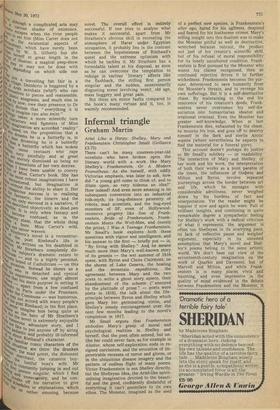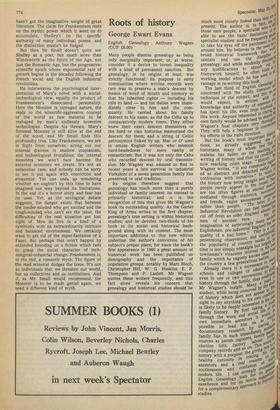Infernal triangle
Graham Martin
Ariel Like a Harpy: Shelley, Mary and Frankenstein Christopher Small (Gollancz £3.75) There can't be many nineteen-year-old novelists who have broken upon the literary world with a work like Mary Shelley's Frankenstein, Or A Modern Prometheus. As she herself, with oddly Victorian emphasis, was later to ask, how did " a young girl come to think of, and to dilate upon, so very hideous an idea?" How indeed? And even more amazing is its subsequent conversion into an industrial folk-myth, its long-distance paternity of robots, mad scientists, and the bug-eyed monsters of SF, even of Hollywoodrecessive progeny like Son of Frankenstein, Bride of Frankenstein, Frankenstein Meets the Wolf-Man, and (surely the prize), I Was A Teenage Frankenstein. Mr Small's book explores both these questions with vigour and intelligence, and his answer to the first — briefly put — is, " By living with Shelley." And he means much more than Mary's well-known story of its genesis — the wet summer of 1816 spent, with Byron and Claire Clairmont, on the shores of Lake Geneva, the boating and the mountain expeditions, the agreement between Mary and the two poets to write a ghost story apiece, their abandonment of the scheme (" annoyed by the platitude of prose" — poets were poets in 1816), the talk about the lifeprinciple between Byron and Shelley which gave Mary her germinating vision, and Shelley's steady encouragement over the next few months leading to the novel's completion in 1817. Mr Small argues that Frankenstein embodies Mary's grasp of moral and psychological realities in Shelley and herself, that the poet often sensed, but unlike her could never face, as for example in Alastor, whose self-exploration ends in resigned narcissism, and the evocation of impenetrable recesses of terror and gloom, or in the ubiquitous disease imagery and the pattern of endless flight of many poems. Victor Frankenstein is not Shelley directly, but the Shelleyan Idea, the Ariel-like spiritualising imagination devoted to the beautiful and the good, confidently disdainful of everything it can't assimilate to its own ethos. The Monster, imagined as the seed of a perfect new species, is Frankenstein's after ego, hated for his ugliness, despised and feared for his loathsome crimes. Mary's telling insight into this dualism was to make the Monster pitiful as well as destructive, wretched because outcast, the product not just of his creator's scientific skill, but of his refusal of moral responsibility for its lonely uncultured condition. Frankenstein is first pursued by the Monster who wants his claims recognised, then as continued rejection drives it to further wickedness, Frankenstein becomes the pursuer, determined to save humanity from the Monster's threats, and to revenge his own sufferings. But it is a self-destructive chase. By maintaining to the end his innocence of his creature's deeds, Frankenstein never overcomes his self-dissociation into humanitarian idealist and irrational criminal. Even the Monster has greater self-knowledge. When at last Frankenstein dies, exhausted by the chase, he mourns his loss, and goes off to destroy himself in the dark and sterile Arctic wastes (where nevertheless he expects to find the material for a funeral pyre).
This account doesn't perhaps do justice to Mr Small's subtlety — or readability. The interaction of Mary and Shelley, of her work and his work, the interpretation of both their works as a joint parable of the times, the influences of Godwin and Milton and Byron, involve repeated journeyings across the border between art and life, which he manages with considerable adroitness, never weighed down by his burdens of fact and interpretation. Yet the reader might be happier if now and again he were. Full of brilliant insights, and combining in quite remarkable degree a sympathetic feeling for Shelley's work with a radical criticism of what it represents, the argument is often too Shelleyan in its scurrying pace, its lack of reflective pause and weighed argument, especially in its untested assumption that Mary's novel and Shelley's poems belong to the same artistic world. We don't base our view of the seventeenth-century imagination on the work of Quarles and Davenent, but of Marvell and Milton, and while Frankenstein is in many places vivid and haunting, and even impressive in the quality of mind evidenced in the debate between Frankenstein and the Monster, it hasn't got the imaginative weight of great literature. The claim for Frankenstein rests on the mythic power which it went on to accumulate, Shelley's on the specific authority of many individual poems, and the distinction mustn't be fudged.
But then Mr Small doesn't quite see Shelley as a poet, but much more than Wordsworth as the Spirit of the Age, not just the Romantic Age, but the progressivescientific epoch whose exponential rate of growth begins in the decades following the French social and the English industrial revolutions.
He interweaves the psychological interpretation of Mary's novel with a socialtechnological view, equally the product of Frankenstein's dissociated personality. Here the Monster is outraged nature, the reply to the scientific-aggressive concept of the world as raw material to be reshaped by man's endlessly inventive technologies. Despite his threats, Mary's fictional Monster is still alive at the end of the novel, and Mr Small finds this profoundly true. Like Frankenstein, we are in flight from ourselves, acting out our internal distress in shallow utopianism, and technological brutalities; the internal monsters we won't face become the external monsters we create. It's not an unfamiliar case, and nobody can be sorry to see it put again with conviction and eloquence. Yet one ends up wondering whether we oughtn't by this time to have imagined our way beyond its limitations. In the end it's a horror story and fear has its uses. Yet, as the ecological debate suggests, the danger exists that between the tender-minded who get excited and the tough-minded who can't see the issue, the difficulties of the real situation get lost sight of. Men do live in a kind of a symbiosis with an extraordinarily intricate and balanced environment. We certainly want to get rid of the super-fantasies of a Faust. But perhaps that won't happen by extended brooding on a fiction which fails to grasp the social character of technoligical-industrial change. Frankenstein is, in the end, a romantic myth. The figure of the mad scientist dodges the issue. It's not as individuals that we threaten our world, but as collectives and as institutions. And if, as Mr. Small would recommend, the Monster is to be made genial again, we need a different kind of myth.











































 Previous page
Previous page